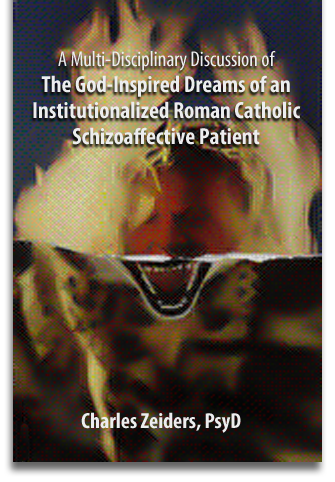A Multi-disciplinary Discussion of the God-Inspired Dreams of an Institutionalized Roman Catholic Schizoaffective Patient
 The medical model is a testament to human ingenuity and to how fearfully and wonderfully we are made. It is a model that enables us to diagnose and treat mental illness with incredible efficiency. The Christian clinician, however, finds it humbling and inspiring to witness God break into human paradigms and procedures like diagnosis and treatment. This article examines the healing of the identity of a man diagnosed with Schizoaffective Disorder. This patient came to identify with his diagnosis. Hyper exposure to the medical model of mental illness drove him to develop an iatrogenic, or treatment induced, conception of himself. He identified himself as a Schizoaffective man, as opposed to a health-positive self-identification such as “Imago Dei.” Following the presentation of case material, focused mainly on God-inspired dreams, a multi-disciplinary panel explores the patient’s dreams from medical, spiritual, and psychological perspectives. What follows is a redacted version of a presentation to the Association of Christian Therapists Healing Manual Preconference Seminar (HMPS) made in Little Rock, Arkansas during the 2007 International Conference of the Association of Christian Therapists. This print version is a joint publication of the HMPS and the Think Tank for Christian Holism of the Institute for Christian Healing (ICH).
The medical model is a testament to human ingenuity and to how fearfully and wonderfully we are made. It is a model that enables us to diagnose and treat mental illness with incredible efficiency. The Christian clinician, however, finds it humbling and inspiring to witness God break into human paradigms and procedures like diagnosis and treatment. This article examines the healing of the identity of a man diagnosed with Schizoaffective Disorder. This patient came to identify with his diagnosis. Hyper exposure to the medical model of mental illness drove him to develop an iatrogenic, or treatment induced, conception of himself. He identified himself as a Schizoaffective man, as opposed to a health-positive self-identification such as “Imago Dei.” Following the presentation of case material, focused mainly on God-inspired dreams, a multi-disciplinary panel explores the patient’s dreams from medical, spiritual, and psychological perspectives. What follows is a redacted version of a presentation to the Association of Christian Therapists Healing Manual Preconference Seminar (HMPS) made in Little Rock, Arkansas during the 2007 International Conference of the Association of Christian Therapists. This print version is a joint publication of the HMPS and the Think Tank for Christian Holism of the Institute for Christian Healing (ICH).
The Case of Murphy*
Adding to my rounds at a geriatric hospital, the attending physician assigned me to be Murphy’s psychotherapist. Receiving the order, I introduced myself to this new patient, “Hello, I am Dr. Zeiders.” He extended his hand but failed to say, “Hello. My name is Murphy,” Instead, he announced, “Hello. I am Schizoaffective.” Murphy had been diagnosed with Schizoaffective Disorder but despite several years of quality medical treatment and an environment in which to practice his long neglected Catholic faith, he had not been made whole. He had come to identify with his mental health diagnosis. And indeed his diagnosis was formidable. The features this man’s Schizoaffective disorder included periods of mania and depression, as well as periods of delusions and hallucinations during a 2 week absence of mood symptoms. Historically, Murphy had also presented occasionally with catatonic stupor. And prior to his placement in the treatment setting, he was positive for alcohol abuse as a related but not causal factor in his mood and psychotic symptoms. Murphy suffered immensely from his chronic illness and became so institutionalized that he introduced himself as his disease. It sounds absurd, but this institutionalized man had the iatrogenic identity as a Schizoaffective man. The mental healthcare delivery system failed to prevent him from identifying with his mental illness. This is problematic simply because people are not their pathologies. Beginning treatment, this 62-year-old Irish Catholic man told me his interesting life story. He talked about growing up Irish Catholic in south Philadelphia in the nineteen fifties. He told stories of his large Irish Catholic family, his intact Irish immigrant culture, his tight-knit community, and coming-of-age adventures. He reminisced about playing baseball, fighting Italian gangs, and attending boxing matches. He told wonderful stories about the priests and the nuns who formed him spiritually, and how they tried to rein in his exuberance or bolster him against inexplicable sorrow. Murphy’s were exceptional stories. But his stories contained elements psychotherapists recognize as emerging signs and symptoms of psychopathology. Throughout his development, for example, he heard voices which others did not hear. He attributed them to “sanctification,” – an interlocution from the world of saints- but puzzled that perhaps some other equally inscrutable process was at work. Sometimes he felt frightened and deeply concerned that a malevolent force was persecuting him. Sometimes he experienced too profound an exuberance in a skyrocketed mood. No one knew what to do with him- neither the nuns nor the priest nor his family. He was too elated. At other times, he experienced such deep sorrow and enervation that he was bedbound, and his ability to experience pleasure simply vanished along with the projects he had started while joyful.
Click Here to Download and Read this Article in its entirety.